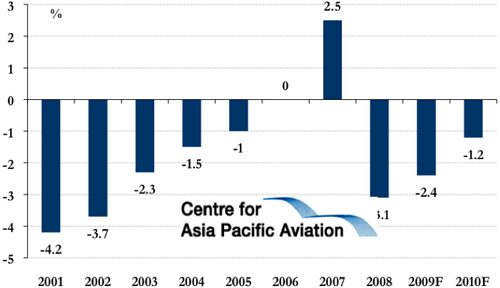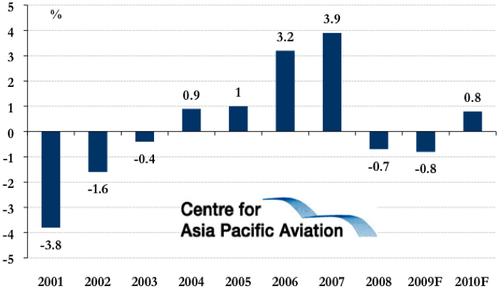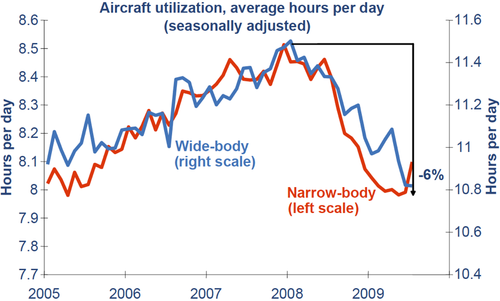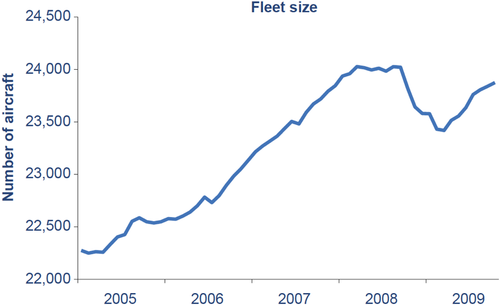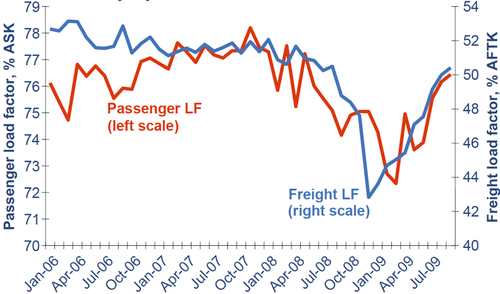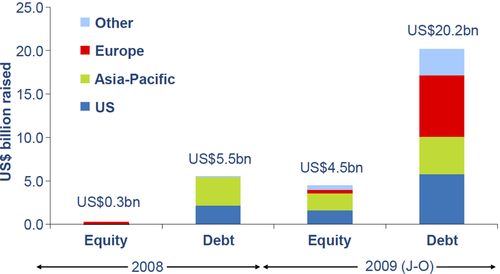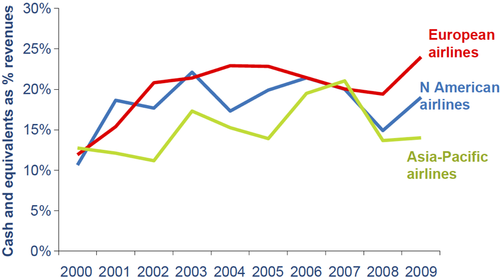IATA predicting wider industry loss of USD5.6 billion for 2010, due to yield weakness
The International Air Transport Association (IATA) revised its financial outlook for 2010 to an expected USD5.6 billion global net loss, significantly worse than the previously forecast loss of USD3.8 billion.
The revised forecast was due to "renewed downward pressure on yields, together with an upward revision to oil and jet fuel prices", which are expected to more than negative the improved economic growth and passenger growth forecasts.
IATA Director General and CEO, Giovanni Bisignani, commented, "we are ending an Annus Horribilis that brings to a close the 10 challenging years of an aviation Decennis Horribilis. Between 2000 and 2009, airlines lost USD49.1 billion, which is an average of USD5.0 billion per year".
For 2009, IATA maintained its forecast of an USD11 billion net loss, following signs of improvement during 3Q2009 (operating profit for sample airlines was USD2.9 billion, with a net post-tax profit of USD351 million), as a move out of recession and to strong economic growth (particularly in emerging markets) boosted airfreight, then passenger demand. The Association expects a global operating loss of USD3.7 billion in 2009.
Airline industry net profit margins (%): 2001 to 2010F
Airline industry operating profit margins (%): 2001 to 2010F
"The worst is likely behind us" but industry now "structurally out of balance"
Mr Bisignani added that some key statistics are "moving in the right direction" for 2010. Demand will likely continue to improve and airlines are expected to drive down non-fuel unit costs by 1.3%". However, despite these improvements, airlines will "remain firmly in the red in 2010".
IATA also believes that the changes arising as a result of the global economic crisis will have a long-term impact, with Mr Bisignani commenting that the industry is "structurally out of balance".
Bisignani stated the "precipitous" fall in yields will "likely never be fully recovered". He added, "it is difficult to see how this can be balanced on the cost-side of the equation. After almost a decade of cost cutting, non-fuel unit cost reductions will be incremental at best. And the risk of rising fuel costs will be constant. There will be some individual airline success stories. But without relaying the foundations of the industry to facilitate structural change, covering the cost of capital for this hyper-fragmented industry will remain a dream at best".
Yields a "continuing disaster"
According to IATA, "poor yields are driving industry losses", with yields a "continuing disaster" for airlines worldwide.
In 2009, passenger and cargo yields have plummeted by 12% and 15%, respectively, with IATA stating that these "won't improve in 2010". According to IATA, cargo yields are expected to improve by only 0.9% in 2010, with passenger yields not expected to improve from their "extraordinary low level",.
Economy and Premium fares on international markets: 2007 to 2009
Excess capacity and reduced corporate travel budgets a concern
IATA added that the continued yield weakness is being driven by two factors: excess capacity in the market (which is driving lower aircraft utilisation, which is down 6% in 2009) and reduced corporate travel budgets.
Aircraft utilisation, average hours per day (seasonally adjusted): 2005 to 2009
An additional 1,300 aircraft due for delivery in 2010 (representing 5.5% of the fleet) will contribute to 2.8% global capacity growth in 2010, putting continued pressure on yields.
Worldwide fleet size: 2005 to 2009
Revenues to remain below 2008 peak in 2009 and 2010
IATA stated that industry revenues are expected to increase 4.9% to USD478 billion in 2010. However, revenues would remain 11% below the peak of USD535 billion in 2008 and USD30 billion below 2007 levels, when passenger traffic was at similar levels to what is expected in 2010.
Passenger and cargo demand outlook improved; load factors back to pre-recession levels
Following a decline of 4.1% in 2009, passenger traffic is expected to grow by 4.5% in 2010 (stronger than the previously forecast 3.2% in Sep-2009) for 2.28 billion passengers, bringing passenger numbers back in line with the peak recorded in 2007.
The cargo demand forecast has also been upgraded, with IATA expecting cargo to grow by 7% to 37.7 million tonnes in 2010 (stronger than the previously forecast 5%), following a 13% decline in 2009. However, freight volumes will remain 10% below the 41.8 million tonne peak recorded in 2007.
Meanwhile, load factors (passenger and freight) have now returned to pre-recession levels.
Seasonally adjusted load factors (passenger and freight) on international markets: 2006 to 2009
Fuel prices to continue their upward trend
An average oil price of USD75.0 per barrel (Brent) is expected in 2010, according to IATA, up considerably from the USD61.8 average expected for 2009. As a percentage of operating costs, fuel will comprise 26% of the total in 2010, although this is lower than 32% in 2007, but twice the level in 2001/2002.
"Cash cushion" for European and North American carriers
The aviation industry has raised at least USD38 billion in cash in 2009, of which USD25 billion has come from capital markets and USD13 billion from aircraft sale and leasebacks. This ratio of cash to revenues has improved particularly for European and North American airlines, providing a "cash cushion" ahead of the seasonally weak 1Q2010 period, but was flat for Asia Pacific carriers.
Capital market fund raising by airlines (USD billion): 2008 and 2009
Cash and equivalent as a % of revenues - major airlines by region: 2000 to 2009
Europe to generate largest losses in 2010; Latin America profitable
According to IATA, all regions, with the exception of Africa, will see an improvement in 2010 compared to 2009, with European carriers expected to generate the largest losses of any region at USD2.5 billion in 2010. Latin American carriers are expected to be the only profitable regional grouping in both 2009 and 2010.
IATA outlook by region: Dec-2009 Forecast
|
Region |
2009 net profit/loss |
2010 net profit/loss |
IATA commentary |
|---|---|---|---|
|
(USD2.9 billion) |
(USD2.0 billion) |
Relative improvement between 2009 and 2010 is largely the result of pricing power and cost reductions gained through capacity adjustments |
|
|
(USD3.5 billion) |
(USD2.5 billion) |
Slow economic recovery in the region combined with limited ability to adjust capacity due to airport slot regulations is hindering the region's airlines |
|
|
(USD3.4 billion) |
(USD700 million) |
The region is showing the most dramatic improvement, driven by a recovery in some of the region's economies, notably China (China's GDP is now forecast to grow by 9.0% in 2010) |
|
|
USD100 million |
USD100 million |
Will be the only profitable regional grouping in both 2009 and 2010. This is largely due to the benefit of relatively strong economies in South America and the efficiencies gained through regional airline structures. |
|
|
(USD1.2 billion) |
(USD300 million) |
A strong long-haul connection business over Middle East hubs will provide some insulation against the impacts of Dubai's financial difficulties |
|
|
(USD100 million) |
(USD100 million) |
Relatively strong economies and increasingly liberal markets are being offset by competitiveness challenges |
No major bankruptcies expected
Mr Bisignani stated he does not see the threat of major bankruptcies, but added that smaller airlines are having continued difficulty accessing credit and, as a result, they remain "fragile". So far in 2009, IATA has terminated 30 airlines because they could not pay their bills. Of these, 14 have disappeared.
Priorities for 2010: Safety, Environment, 'Simplifying the Business' and 'Financials'
IATA also outlined the following priorities for 2010:
IATA priorities for 2010
|
Priority |
Commentary |
|---|---|
|
Safety |
As at Nov-2009, the industry's accident rate has never been lower, at a rate of one accident for every 1.75 million flights, a 38% year-on-year improvement, and almost half the accident rate from 2000. However, 2009 had three accidents, resulting in 680 fatalities (+35.4% year-on-year). IATA added that the accident rate in Africa is 12 times the global average and Middle East and North Africa is five times the global average. Meanwhile, China is headed for its third year of zero hull losses. Latin America and Russia/CIS also have no hull losses in 2009 |
|
Environment |
IATA stated biofuels "hold the greatest potential" for reducing the impact of aviation on the environment. IATA added that the aviation remains committed to a 1.5% average annual improvement in fuel efficiency to 2020 , stabilizing emissions from 2020 with carbon neutral growth and a 50% net reduction in emissions by 2050 compared to 2005 |
|
Simplifying the Business |
The programme, commenced in Jun-2004, has two project with key 2010 deadlines: - e-freight: by the end of 2010, the target it to have capability in markets that represent 80% of cargo capacity, with IATA also hoping to achieve 100% capacity regarding bar coded boarding passes in 2010, for USD1.5 billion in savings. - A new project for 2010 is to make all transactions between airlines, agents and passengers completely paperless with Electronic Miscellaneous Documents (EMD). In total, IATA is targeting USD16.9 billion in savings with StB. |
|
Financial |
- User Charges: IATA stated it expects to save members USD1.7 billion in airport, ATM and fuel charges in 2009, although 90% of the industry's USD1.0 billion in cost increases were from airports, according to IATA. IATA also outlined success regarding user charges at Singapore Changi, Malaysian Airports, Toronto Pearson, Copenhagen and Aerports de Paris, but expressed disappointment with Indian Airports, Eurocontrol, Dubai, London Heathrow and South Africa. - Liberalisation: IATA stated that is a need to "look at the industry's structure as a cause of the horrible decade", adding that while the current system was approximately for 1945, it is now outdated and irrelevant. Mr Bisignani commented, "Consolidation is the great hope for the industry. The round of consolidation experienced since this horrible decade began is a step in the right direction. But it has been confined within political borders as a result of ownership restrictions in the archaic bilateral system. The industry cannot afford the mounting losses of the status quo. The next decade must facilitate consolidation". |
Outlook: "Worst is likely behind us" but challenges to continue
The good news is that IATA believes that the "worst is likely behind us". However, the industry has taken a couple of steps backwards as a result of the global economic crisis, with 2010 expected to "look much like 2007", with passenger levels and oil to return to level similar to those in 2007.
However, a key difference is that revenues are expected to be USD30 billion less than 2007 levels and further major cost reductions will be "difficult", albeit not impossible.
